maintenance FORD F250 SUPER DUTY 2005 Owners Manual
[x] Cancel search | Manufacturer: FORD, Model Year: 2005, Model line: F250 SUPER DUTY, Model: FORD F250 SUPER DUTY 2005Pages: 312, PDF Size: 4.8 MB
Page 3 of 312
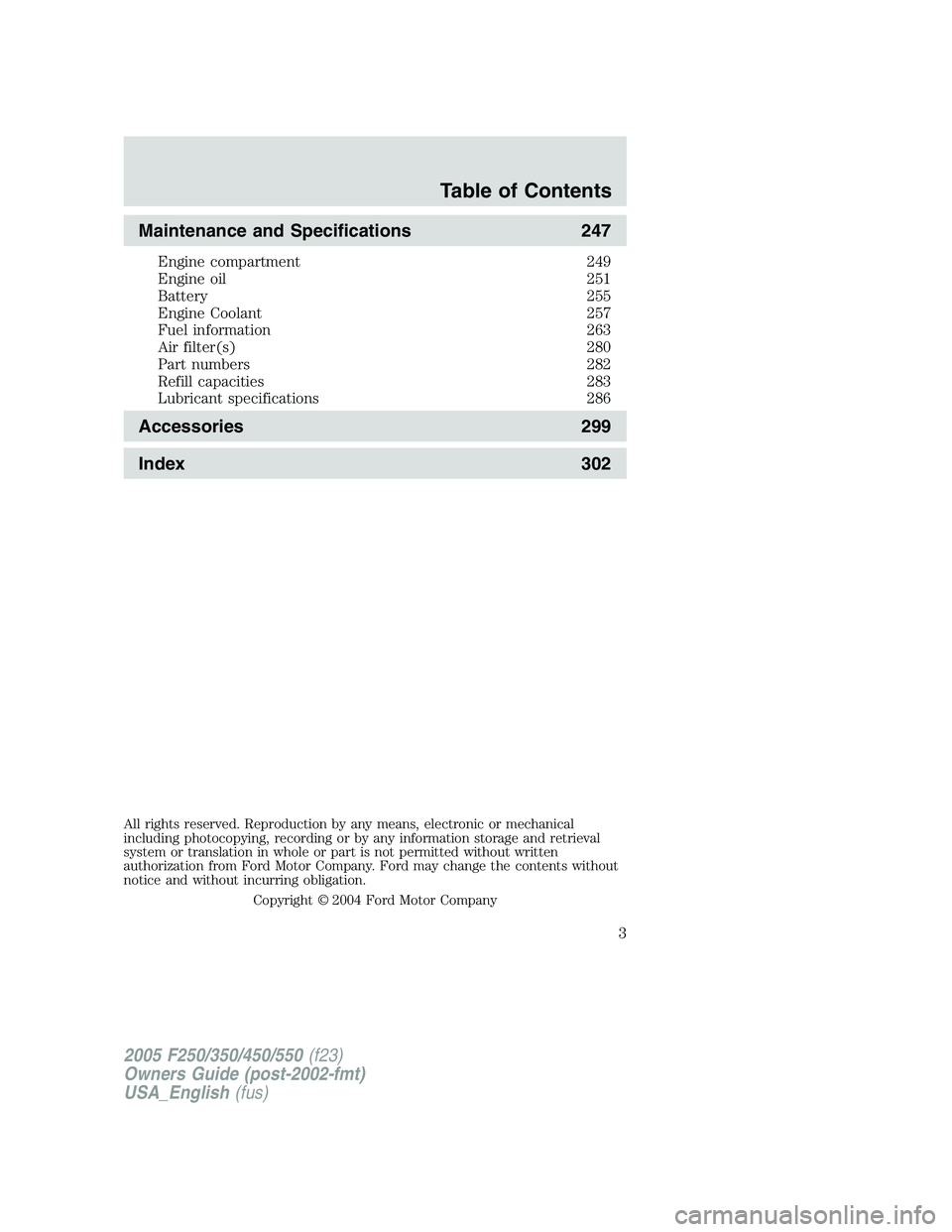
Maintenance and Specifications 247Engine compartment 249
Engine oil 251
Battery 255
Engine Coolant 257
Fuel information 263
Air filter(s) 280
Part numbers 282
Refill capacities 283
Lubricant specifications 286
Accessories 299
Index 302
All rights reserved. Reproduction by any means, electronic or mechanical
including photocopying, recording or by any information storage and retrieval
system or translation in whole or part is not permitted without written
authorization from Ford Motor Company. Ford may change the contents without
notice and without incurring obligation.
Copyright © 2004 Ford Motor Company Table of Contents
3
2005 F250/350/450/550 (f23)
Owners Guide (post-2002-fmt)
USA_English (fus)
Page 5 of 312
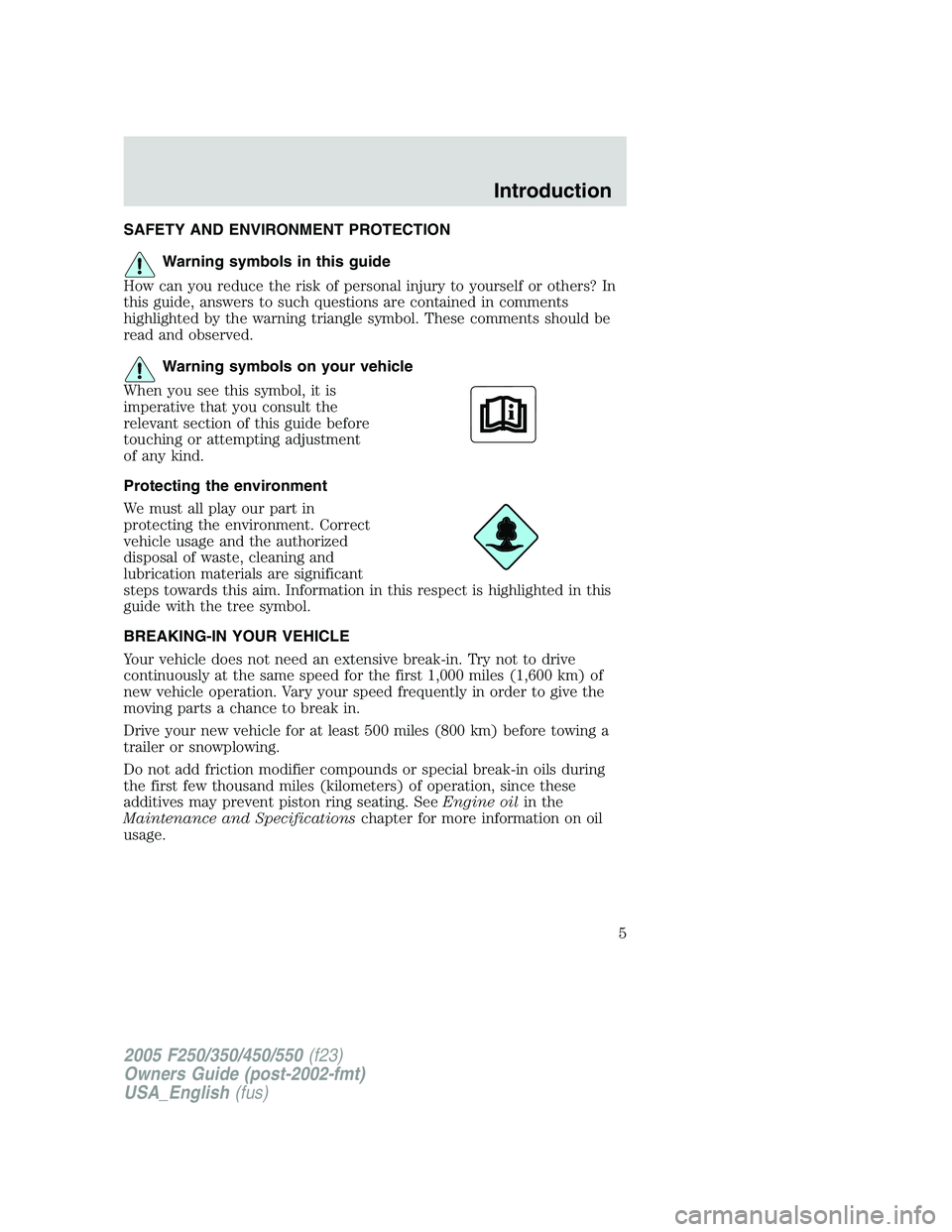
SAFETY AND ENVIRONMENT PROTECTION
Warning symbols in this guide
How can you reduce the risk of personal injury to yourself or others? In
this guide, answers to such questions are contained in comments
highlighted by the warning triangle symbol. These comments should be
read and observed.
Warning symbols on your vehicle
When you see this symbol, it is
imperative that you consult the
relevant section of this guide before
touching or attempting adjustment
of any kind.
Protecting the environment
We must all play our part in
protecting the environment. Correct
vehicle usage and the authorized
disposal of waste, cleaning and
lubrication materials are significant
steps towards this aim. Information in this respect is highlighted in this
guide with the tree symbol.
BREAKING-IN YOUR VEHICLE
Your vehicle does not need an extensive break-in. Try not to drive
continuously at the same speed for the first 1,000 miles (1,600 km) of
new vehicle operation. Vary your speed frequently in order to give the
moving parts a chance to break in.
Drive your new vehicle for at least 500 miles (800 km) before towing a
trailer or snowplowing.
Do not add friction modifier compounds or special break-in oils during
the first few thousand miles (kilometers) of operation, since these
additives may prevent piston ring seating. See Engine oil in the
Maintenance and Specifications chapter for more information on oil
usage.
2005 F250/350/450/550 (f23)
Owners Guide (post-2002-fmt)
USA_English (fus) Introduction
5
Page 7 of 312
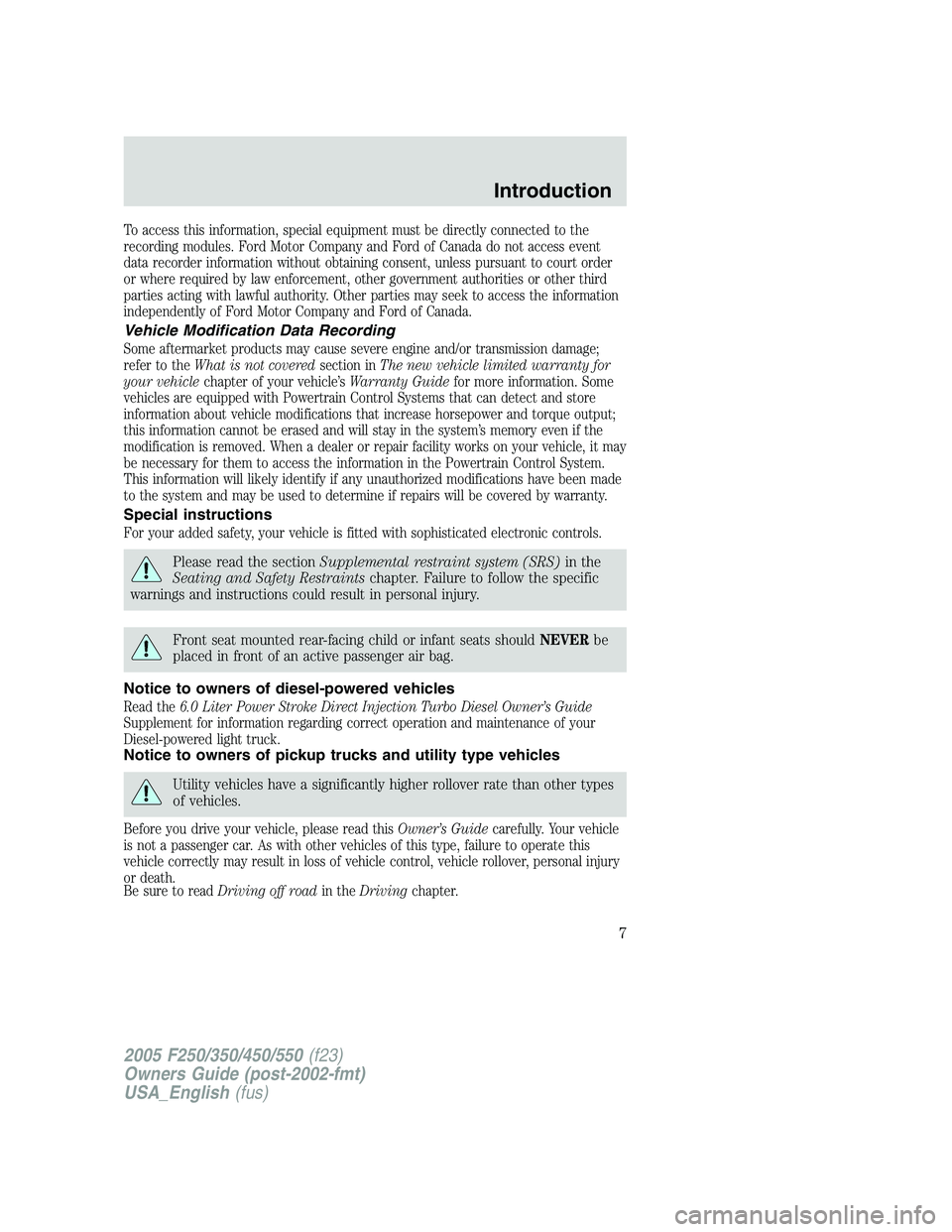
To access this information, special equipment must be directly connected to the
recording modules. Ford Motor Company and Ford of Canada do not access event
data recorder information without obtaining consent, unless pursuant to court order
or where required by law enforcement, other government authorities or other third
parties acting with lawful authority. Other parties may seek to access the information
independently of Ford Motor Company and Ford of Canada.
Vehicle Modification Data Recording
Some aftermarket products may cause severe engine and/or transmission damage;
refer to the What is not covered section in The new vehicle limited warranty for
your vehicle chapter of your vehicle’s Warranty Guide for more information. Some
vehicles are equipped with Powertrain Control Systems that can detect and store
information about vehicle modifications that increase horsepower and torque output;
this information cannot be erased and will stay in the system’s memory even if the
modification is removed. When a dealer or repair facility works on your vehicle, it may
be necessary for them to access the information in the Powertrain Control System.
This information will likely identify if any unauthorized modifications have been made
to the system and may be used to determine if repairs will be covered by warranty.
Special instructions
For your added safety, your vehicle is fitted with sophisticated electronic controls.
Please read the section Supplemental restraint system (SRS) in the
Seating and Safety Restraints chapter. Failure to follow the specific
warnings and instructions could result in personal injury.
Front seat mounted rear-facing child or infant seats should NEVER be
placed in front of an active passenger air bag.
Notice to owners of diesel-powered vehicles
Read the 6.0 Liter Power Stroke Direct Injection Turbo Diesel Owner’s Guide
Supplement for information regarding correct operation and maintenance of your
Diesel-powered light truck.
Notice to owners of pickup trucks and utility type vehicles
Utility vehicles have a significantly higher rollover rate than other types
of vehicles.
Before you drive your vehicle, please read this Owner’s Guide carefully. Your vehicle
is not a passenger car. As with other vehicles of this type, failure to operate this
vehicle correctly may result in loss of vehicle control, vehicle rollover, personal injury
or death.
Be sure to read Driving off road in the Driving chapter.
2005 F250/350/450/550 (f23)
Owners Guide (post-2002-fmt)
USA_English (fus) Introduction
7
Page 13 of 312
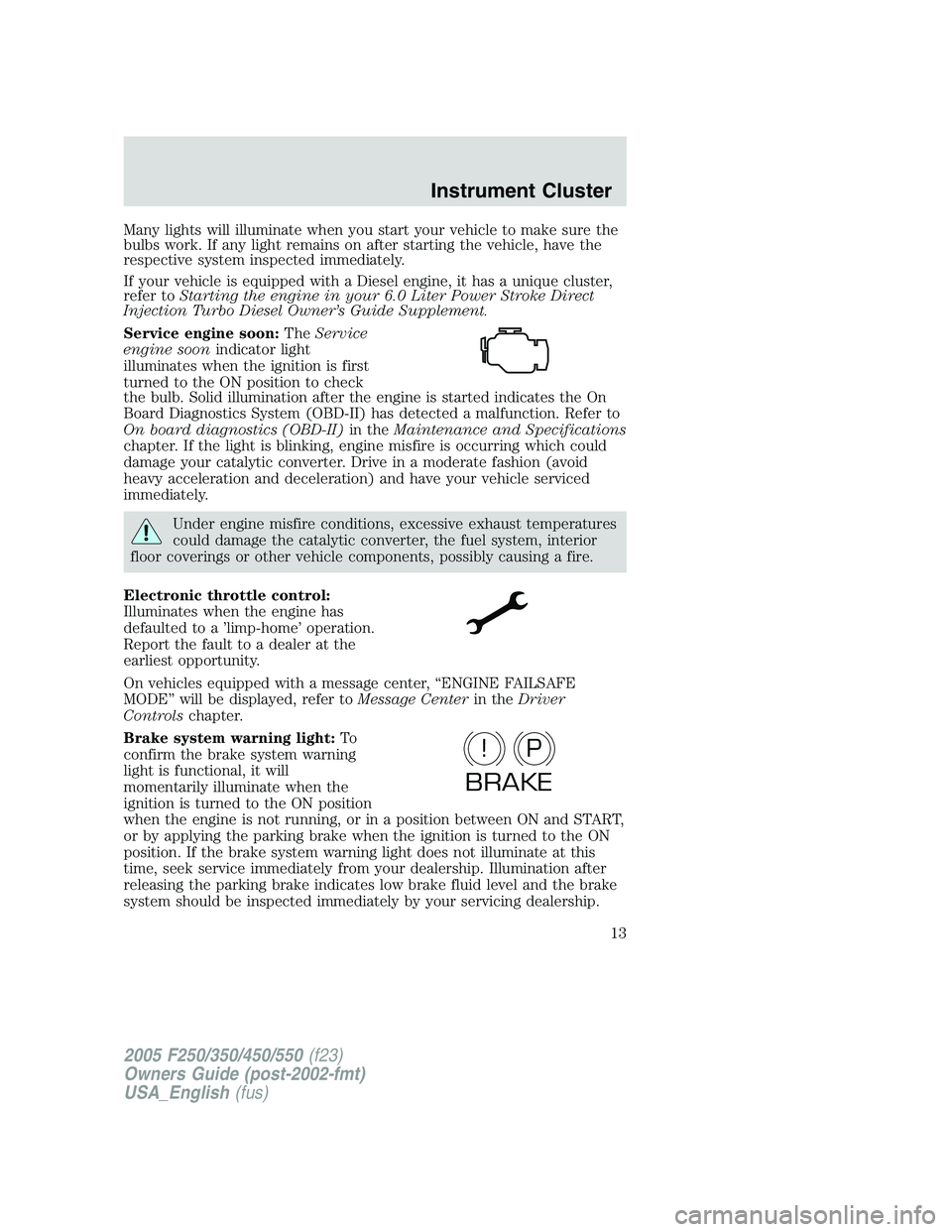
Many lights will illuminate when you start your vehicle to make sure the
bulbs work. If any light remains on after starting the vehicle, have the
respective system inspected immediately.
If your vehicle is equipped with a Diesel engine, it has a unique cluster,
refer to Starting the engine in your 6.0 Liter Power Stroke Direct
Injection Turbo Diesel Owner’s Guide Supplement.
Service engine soon: The Service
engine soon indicator light
illuminates when the ignition is first
turned to the ON position to check
the bulb. Solid illumination after the engine is started indicates the On
Board Diagnostics System (OBD-II) has detected a malfunction. Refer to
On board diagnostics (OBD-II) in the Maintenance and Specifications
chapter. If the light is blinking, engine misfire is occurring which could
damage your catalytic converter. Drive in a moderate fashion (avoid
heavy acceleration and deceleration) and have your vehicle serviced
immediately.
Under engine misfire conditions, excessive exhaust temperatures
could damage the catalytic converter, the fuel system, interior
floor coverings or other vehicle components, possibly causing a fire.
Electronic throttle control:
Illuminates when the engine has
defaulted to a ’limp-home’ operation.
Report the fault to a dealer at the
earliest opportunity.
On vehicles equipped with a message center, “ENGINE FAILSAFE
MODE” will be displayed, refer to Message Center in the Driver
Controls chapter.
Brake system warning light: To
confirm the brake system warning
light is functional, it will
momentarily illuminate when the
ignition is turned to the ON position
when the engine is not running, or in a position between ON and START,
or by applying the parking brake when the ignition is turned to the ON
position. If the brake system warning light does not illuminate at this
time, seek service immediately from your dealership. Illumination after
releasing the parking brake indicates low brake fluid level and the brake
system should be inspected immediately by your servicing dealership.
P!
BRAKE
2005 F250/350/450/550 (f23)
Owners Guide (post-2002-fmt)
USA_English (fus) Instrument Cluster
13
Page 18 of 312
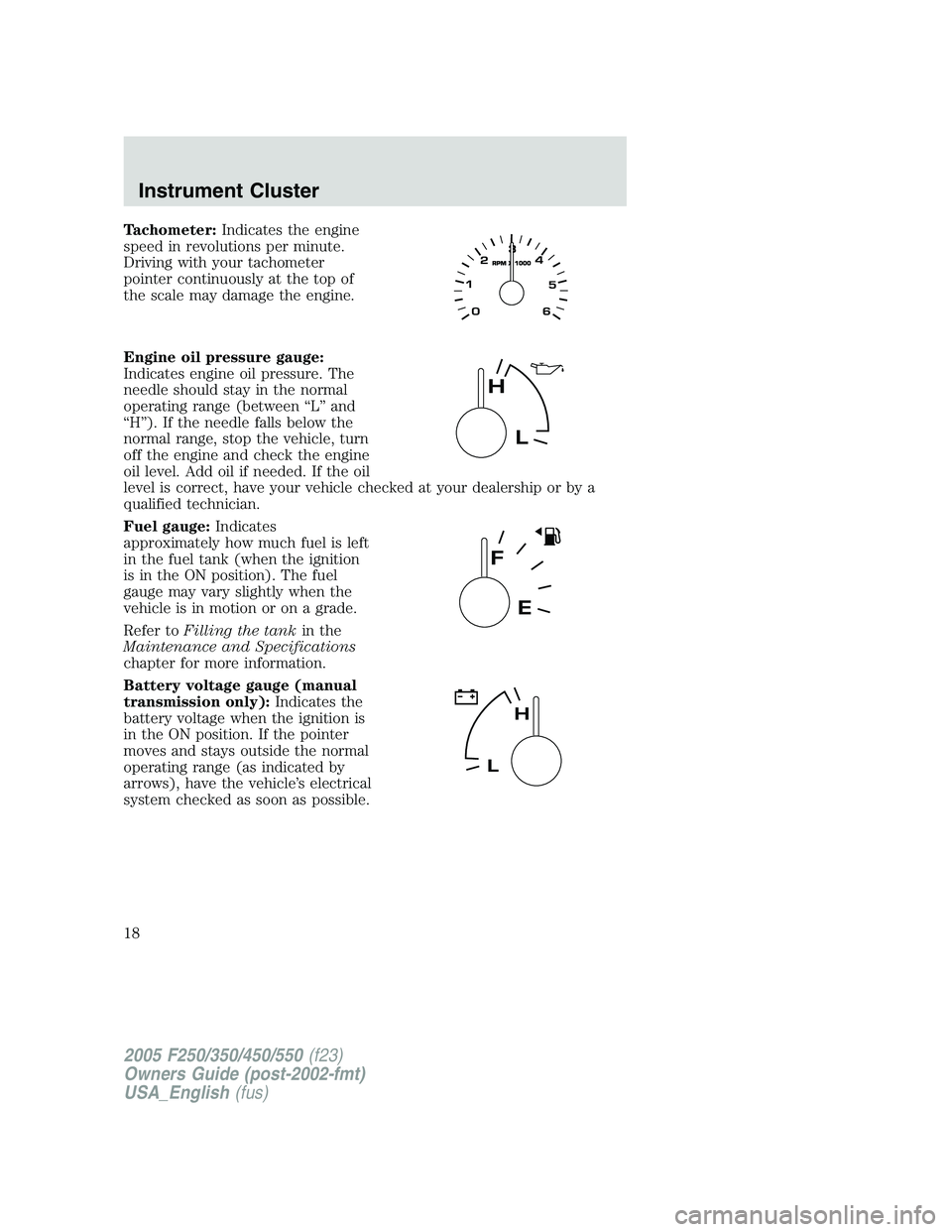
Tachometer: Indicates the engine
speed in revolutions per minute.
Driving with your tachometer
pointer continuously at the top of
the scale may damage the engine.
Engine oil pressure gauge:
Indicates engine oil pressure. The
needle should stay in the normal
operating range (between “L” and
“H”). If the needle falls below the
normal range, stop the vehicle, turn
off the engine and check the engine
oil level. Add oil if needed. If the oil
level is correct, have your vehicle checked at your dealership or by a
qualified technician.
Fuel gauge: Indicates
approximately how much fuel is left
in the fuel tank (when the ignition
is in the ON position). The fuel
gauge may vary slightly when the
vehicle is in motion or on a grade.
Refer to Filling the tank in the
Maintenance and Specifications
chapter for more information.
Battery voltage gauge (manual
transmission only): Indicates the
battery voltage when the ignition is
in the ON position. If the pointer
moves and stays outside the normal
operating range (as indicated by
arrows), have the vehicle’s electrical
system checked as soon as possible.
2005 F250/350/450/550 (f23)
Owners Guide (post-2002-fmt)
USA_English (fus)Instrument Cluster
18
Page 19 of 312
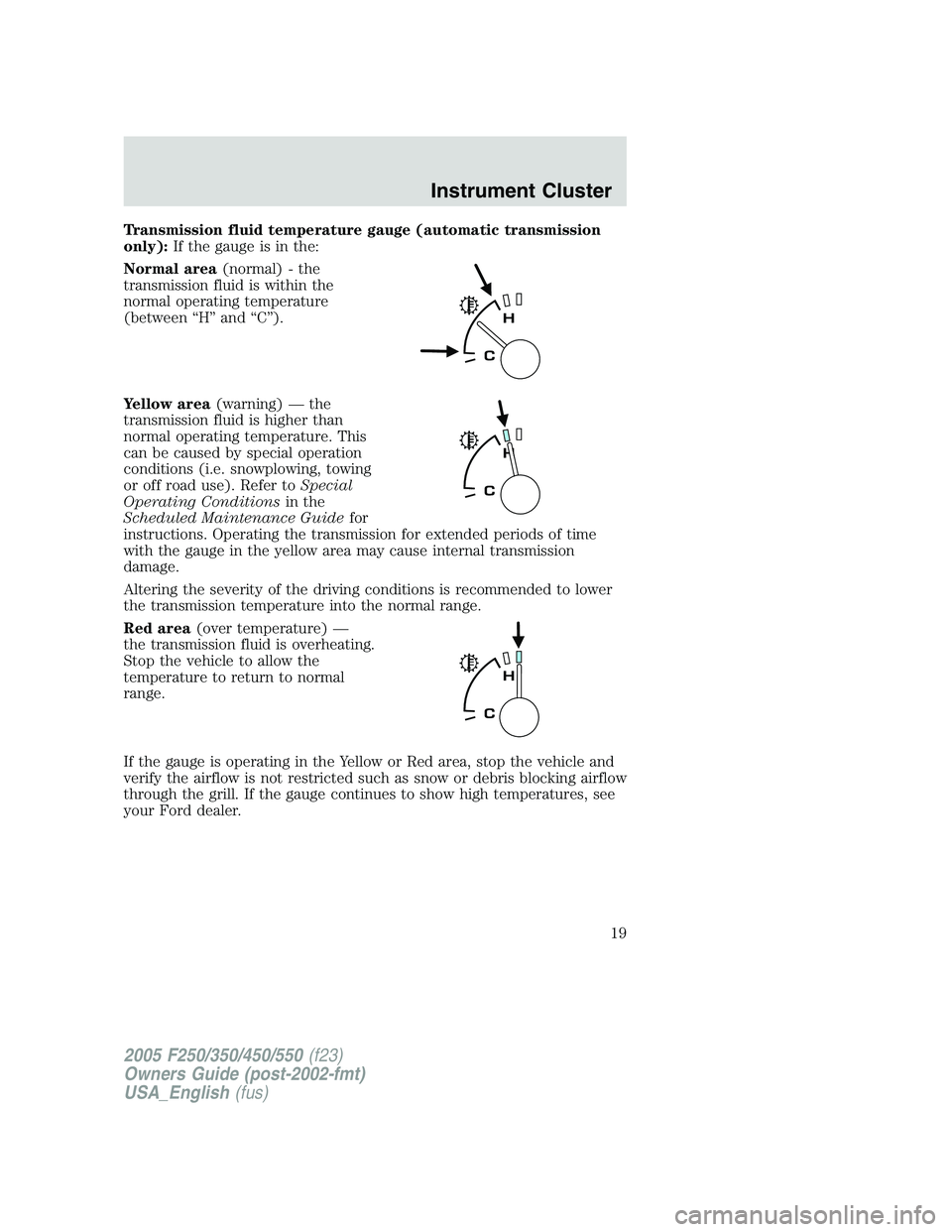
Transmission fluid temperature gauge (automatic transmission
only): If the gauge is in the:
Normal area (normal) - the
transmission fluid is within the
normal operating temperature
(between “H” and “C”).
Yellow area (warning) — the
transmission fluid is higher than
normal operating temperature. This
can be caused by special operation
conditions (i.e. snowplowing, towing
or off road use). Refer to Special
Operating Conditions in the
Scheduled Maintenance Guide for
instructions. Operating the transmission for extended periods of time
with the gauge in the yellow area may cause internal transmission
damage.
Altering the severity of the driving conditions is recommended to lower
the transmission temperature into the normal range.
Red area (over temperature) —
the transmission fluid is overheating.
Stop the vehicle to allow the
temperature to return to normal
range.
If the gauge is operating in the Yellow or Red area, stop the vehicle and
verify the airflow is not restricted such as snow or debris blocking airflow
through the grill. If the gauge continues to show high temperatures, see
your Ford dealer.
2005 F250/350/450/550 (f23)
Owners Guide (post-2002-fmt)
USA_English (fus) Instrument Cluster
19
Page 67 of 312
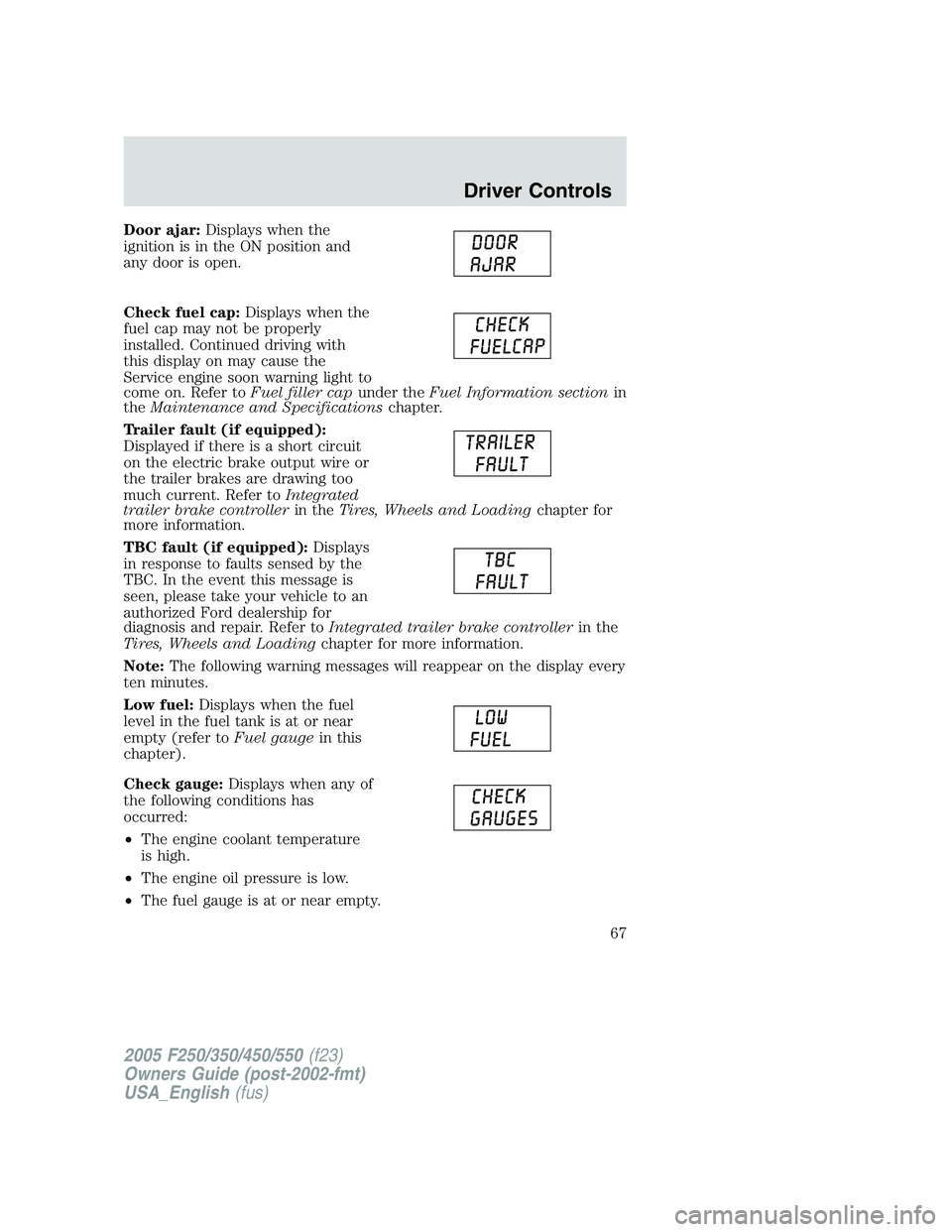
Door ajar: Displays when the
ignition is in the ON position and
any door is open.
Check fuel cap: Displays when the
fuel cap may not be properly
installed. Continued driving with
this display on may cause the
Service engine soon warning light to
come on. Refer to Fuel filler cap under the Fuel Information section in
the Maintenance and Specifications chapter.
Trailer fault (if equipped):
Displayed if there is a short circuit
on the electric brake output wire or
the trailer brakes are drawing too
much current. Refer to Integrated
trailer brake controller in the Tires, Wheels and Loading chapter for
more information.
TBC fault (if equipped): Displays
in response to faults sensed by the
TBC. In the event this message is
seen, please take your vehicle to an
authorized Ford dealership for
diagnosis and repair. Refer to Integrated trailer brake controller in the
Tires, Wheels and Loading chapter for more information.
Note: The following warning messages will reappear on the display every
ten minutes.
Low fuel: Displays when the fuel
level in the fuel tank is at or near
empty (refer to Fuel gauge in this
chapter).
Check gauge: Displays when any of
the following conditions has
occurred:
• The engine coolant temperature
is high.
• The engine oil pressure is low.
• The fuel gauge is at or near empty.
2005 F250/350/450/550 (f23)
Owners Guide (post-2002-fmt)
USA_English (fus) Driver Controls
67
Page 75 of 312
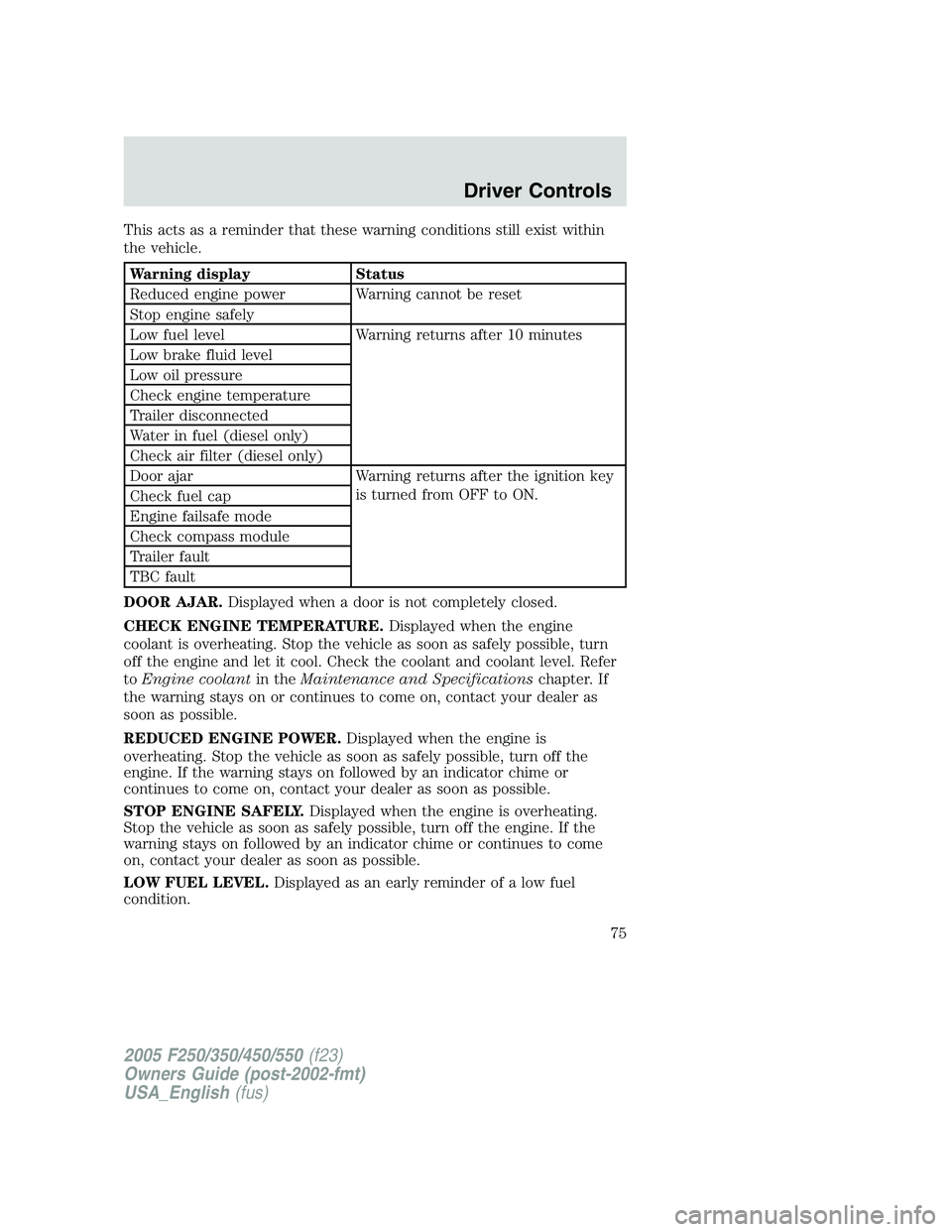
This acts as a reminder that these warning conditions still exist within
the vehicle.
Warning display Status
Reduced engine power Warning cannot be reset
Stop engine safely
Low fuel level Warning returns after 10 minutes
Low brake fluid level
Low oil pressure
Check engine temperature
Trailer disconnected
Water in fuel (diesel only)
Check air filter (diesel only)
Door ajar Warning returns after the ignition key
is turned from OFF to ON.
Check fuel cap
Engine failsafe mode
Check compass module
Trailer fault
TBC fault
DOOR AJAR. Displayed when a door is not completely closed.
CHECK ENGINE TEMPERATURE. Displayed when the engine
coolant is overheating. Stop the vehicle as soon as safely possible, turn
off the engine and let it cool. Check the coolant and coolant level. Refer
to Engine coolant in the Maintenance and Specifications chapter. If
the warning stays on or continues to come on, contact your dealer as
soon as possible.
REDUCED ENGINE POWER. Displayed when the engine is
overheating. Stop the vehicle as soon as safely possible, turn off the
engine. If the warning stays on followed by an indicator chime or
continues to come on, contact your dealer as soon as possible.
STOP ENGINE SAFELY. Displayed when the engine is overheating.
Stop the vehicle as soon as safely possible, turn off the engine. If the
warning stays on followed by an indicator chime or continues to come
on, contact your dealer as soon as possible.
LOW FUEL LEVEL. Displayed as an early reminder of a low fuel
condition.
2005 F250/350/450/550 (f23)
Owners Guide (post-2002-fmt)
USA_English (fus) Driver Controls
75
Page 76 of 312
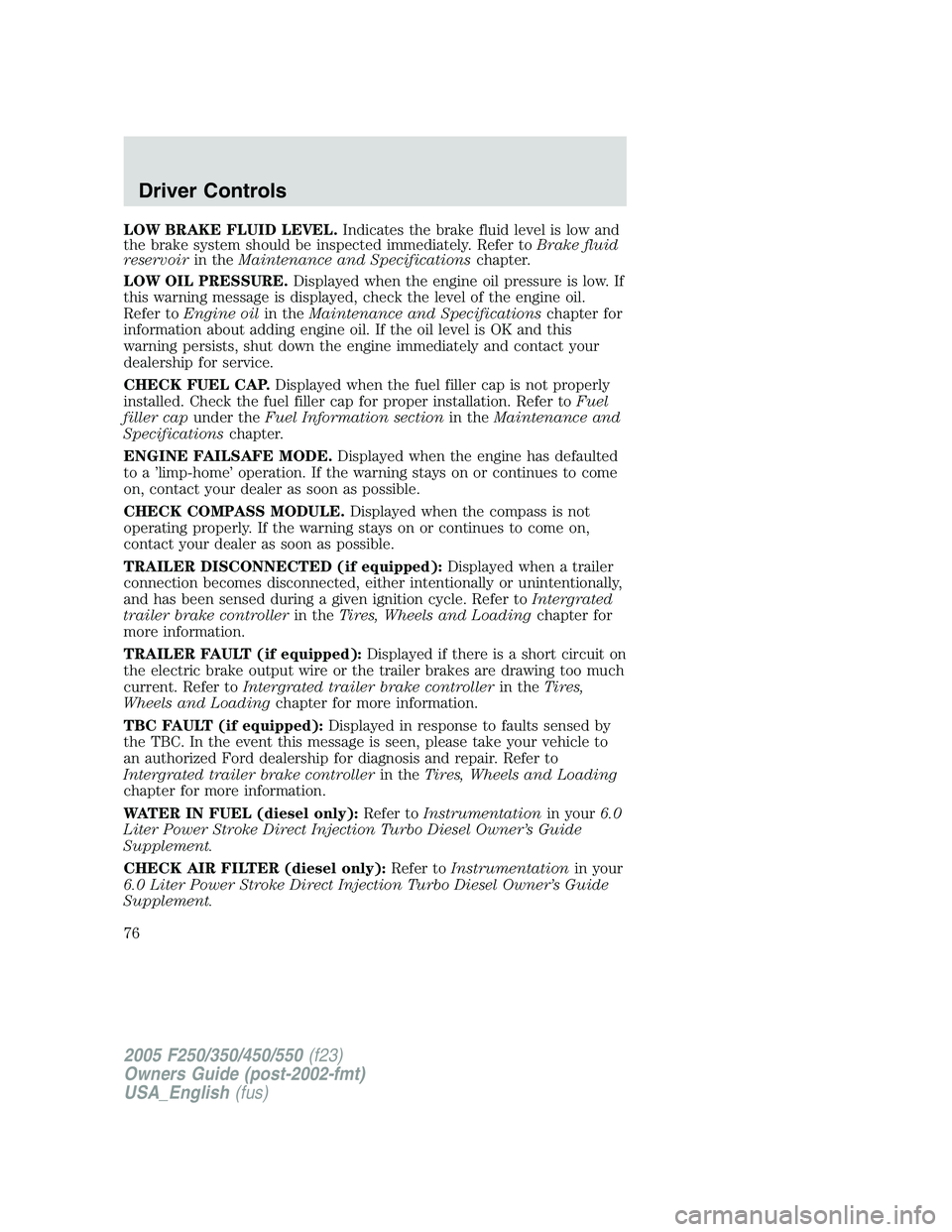
LOW BRAKE FLUID LEVEL. Indicates the brake fluid level is low and
the brake system should be inspected immediately. Refer to Brake fluid
reservoir in the Maintenance and Specifications chapter.
LOW OIL PRESSURE. Displayed when the engine oil pressure is low. If
this warning message is displayed, check the level of the engine oil.
Refer to Engine oil in the Maintenance and Specifications chapter for
information about adding engine oil. If the oil level is OK and this
warning persists, shut down the engine immediately and contact your
dealership for service.
CHECK FUEL CAP. Displayed when the fuel filler cap is not properly
installed. Check the fuel filler cap for proper installation. Refer to Fuel
filler cap under the Fuel Information section in the Maintenance and
Specifications chapter.
ENGINE FAILSAFE MODE. Displayed when the engine has defaulted
to a ’limp-home’ operation. If the warning stays on or continues to come
on, contact your dealer as soon as possible.
CHECK COMPASS MODULE. Displayed when the compass is not
operating properly. If the warning stays on or continues to come on,
contact your dealer as soon as possible.
TRAILER DISCONNECTED (if equipped): Displayed when a trailer
connection becomes disconnected, either intentionally or unintentionally,
and has been sensed during a given ignition cycle. Refer to Intergrated
trailer brake controller in the Tires, Wheels and Loading chapter for
more information.
TRAILER FAULT (if equipped): Displayed if there is a short circuit on
the electric brake output wire or the trailer brakes are drawing too much
current. Refer to Intergrated trailer brake controller in the Tires,
Wheels and Loading chapter for more information.
TBC FAULT (if equipped): Displayed in response to faults sensed by
the TBC. In the event this message is seen, please take your vehicle to
an authorized Ford dealership for diagnosis and repair. Refer to
Intergrated trailer brake controller in the Tires, Wheels and Loading
chapter for more information.
WATER IN FUEL (diesel only): Refer to Instrumentation in your 6.0
Liter Power Stroke Direct Injection Turbo Diesel Owner’s Guide
Supplement.
CHECK AIR FILTER (diesel only): Refer to Instrumentation in your
6.0 Liter Power Stroke Direct Injection Turbo Diesel Owner’s Guide
Supplement.
2005 F250/350/450/550 (f23)
Owners Guide (post-2002-fmt)
USA_English (fus)Driver Controls
76
Page 107 of 312
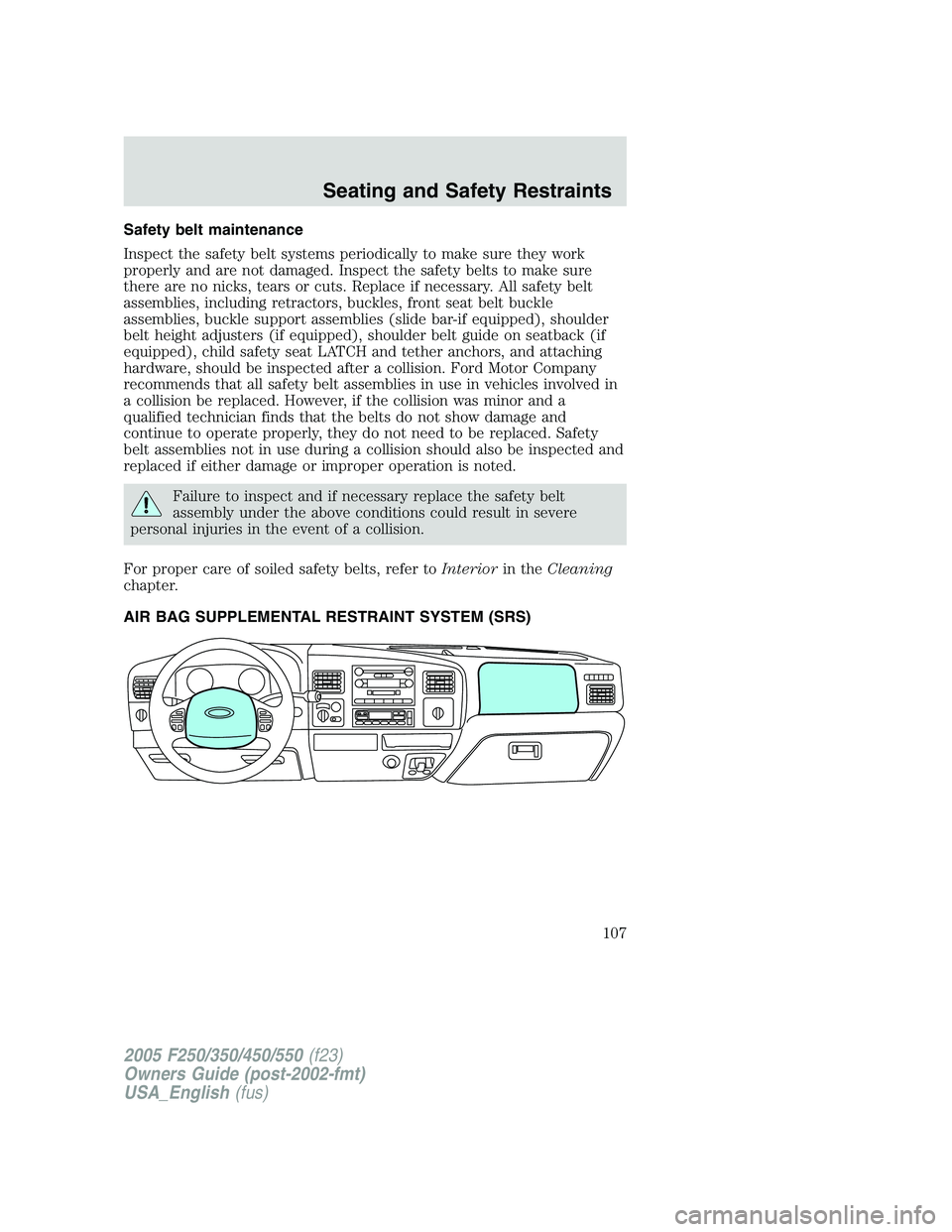
Safety belt maintenance
Inspect the safety belt systems periodically to make sure they work
properly and are not damaged. Inspect the safety belts to make sure
there are no nicks, tears or cuts. Replace if necessary. All safety belt
assemblies, including retractors, buckles, front seat belt buckle
assemblies, buckle support assemblies (slide bar-if equipped), shoulder
belt height adjusters (if equipped), shoulder belt guide on seatback (if
equipped), child safety seat LATCH and tether anchors, and attaching
hardware, should be inspected after a collision. Ford Motor Company
recommends that all safety belt assemblies in use in vehicles involved in
a collision be replaced. However, if the collision was minor and a
qualified technician finds that the belts do not show damage and
continue to operate properly, they do not need to be replaced. Safety
belt assemblies not in use during a collision should also be inspected and
replaced if either damage or improper operation is noted.
Failure to inspect and if necessary replace the safety belt
assembly under the above conditions could result in severe
personal injuries in the event of a collision.
For proper care of soiled safety belts, refer to Interior in the Cleaning
chapter.
AIR BAG SUPPLEMENTAL RESTRAINT SYSTEM (SRS)
2005 F250/350/450/550 (f23)
Owners Guide (post-2002-fmt)
USA_English (fus) Seating and Safety Restraints
107